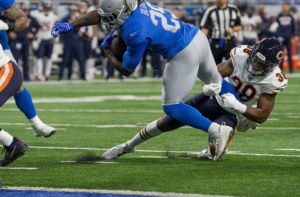On Wednesday, I looked at all running backs with at least 100 carries. Then, for those running backs who averaged over 4.41 yards per carry (the average YPC for that group), I asked the question: how many of the best rushes would you need to discard for each running back to have an average (or worse) YPC average?
The answer was not many. For Todd Gurley and Gus Edwards, who led the league in this metric, the answer was just 6 runs. Taking away Gurley’s 6 best carries dropped his YPC average to 4.34; taking away his 5 best would have dropped his YPC to “only” 4.43, so you need to take away his best 6 carries to get him to average or below.
But what about the reverse? If we look at all running backs with at least 100 carries who averaged fewer than 4.41 yards per carry, how many of their worst rushes would you need to discard to get that running back to average or better?
The leader in this category is LeGarrette Blount, and it wasn’t particularly close. In 2018, the Lions running back rushed 154 times for just 418 yards, an abysmal 2.71 YPC average.
If you took away Blount’s worst 10 carries, his YPC average only jumps to 3.16. If you took away his worst 20 carries he goes to 3.49, worst 30 raises him to 3.81, and worst 40 to 4.14. If you took away Blount’s worst 47 carries last year — which represented 31% of his total carries, by the way — his YPC would *still* only be 4.39, below the average of all running backs with 100 carries! So for Blount, the answer is 48 carries: that’s how many you need to remove to get his YPC to average or above. Take a look:
His teammate, rookie Kerryon Johnson, rushed for 421 yards on his 27 best rushes. Blount rushed for 418 yards on 154 carries for the season.
The table below shows how many of the worst carries you would need to take away to get them above average, for all RBs with at least 100 carries last year and a YPC average below 4.41.

Thoughts?

